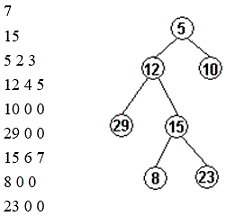一本通-1367:查找二叉树(tree_a)¶
【题目描述】 已知一棵二叉树用邻接表结构存储,中序查找二叉树中值为x的结点,并指出是第几个结点。例:如图二叉树的数据文件的数据格式如下:

【输入】 第一行n为二叉树的结点个树,n≤100;第二行x表示要查找的结点的值;以下第一列数据是各结点的值,第二列数据是左儿子结点编号,第三列数据是右儿子结点编号。
【输出】 一个数即查找的结点编号。
【输入样例】 7 15 5 2 3 12 4 5 10 0 0 29 0 0 15 6 7 8 0 0 23 0 0
【输出样例】 4
最开始的思路是建树,然后辅助栈中序遍历即可,虽然并不需要建树,但是还是练习一下。
#include <bits/stdc++.h>
using namespace std;
struct Node
{
int val;
int leftNode, rightNode;
};
struct TreeNode
{
int val;
TreeNode *left, *right;
TreeNode(int x): val(x), left(NULL), right(NULL) {}
};
vector<Node> seq(105);
int n;
int target, step = 0;
TreeNode *build(int pos)
{
if (!pos) return NULL;
TreeNode *root = new TreeNode(seq[pos].val);
root -> left = build(seq[pos].leftNode);
root -> right = build(seq[pos].rightNode);
return root;
}
void inorderTraversal(TreeNode *root)
{
if (!root) return;
stack<TreeNode*> s;
TreeNode *p = root;
while (!s.empty() || p) {
if (p) {
s.push(p);
p = p -> left;
}
else {
p = s.top(); s.pop();
++step;
if (p -> val == target) return;
p = p -> right;
}
}
}
void makeEmpty(TreeNode *& root)
{
if (root) {
makeEmpty(root -> left);
makeEmpty(root -> right);
delete root;
root = NULL;
}
}
int solve()
{
TreeNode *root = build(1);
inorderTraversal(root);
makeEmpty(root);
return step;
}
int main()
{
std::ios_base::sync_with_stdio(false);
cin.tie(NULL);
cout.tie(NULL);
cin >> n >> target;
for (int i = 1; i <= n; ++i) {
cin >> seq[i].val >> seq[i].leftNode >> seq[i].rightNode;
}
cout << solve() << endl;
return 0;
}
也可以不用建树,因为每个节点已经给出了左右节点的编号,就相当于建树了。
#include <bits/stdc++.h>
using namespace std;
struct Node
{
int val;
int leftNode, rightNode;
};
vector<Node> seq(105);
int n;
int target, step = 0;
void inorderTraversal(int pos)
{
if (seq[pos].leftNode) inorderTraversal(seq[pos].leftNode);
++step;
if (seq[pos].val == target) {
cout << step << endl;
exit(0);
}
if (seq[pos].rightNode) inorderTraversal(seq[pos].rightNode);
}
int main()
{
std::ios_base::sync_with_stdio(false);
cin.tie(NULL);
cout.tie(NULL);
cin >> n >> target;
for (int i = 1; i <= n; ++i) {
cin >> seq[i].val >> seq[i].leftNode >> seq[i].rightNode;
}
inorderTraversal(1);
return 0;
}